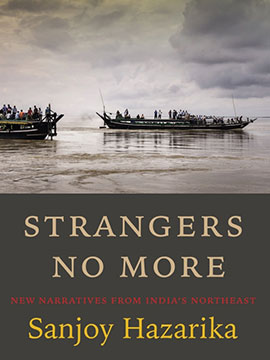There are three kinds of media people who travel to the North-East of India: the north-easterners who have had to desert the sylvan vales of their region as economic refugees; career adventure journalists who like to get stellar roles in their chosen profession from the blood spilled; and few reluctant reporters who just cannot avoid the ‘bad’ news emanating from the region. Sanjay Hazarika belongs to neither category. He was born into an Indian mainstream family, started his journalism career with the venerable New York Times, and enjoyed the privileges of having been a recipient of all the largesse his family could afford. Added to that was his power and influence that his blue ribbon job got him. But North-East did not let him remain alone like an outsider looking in. Instead, Sanjay was driven to explore the region with its warts and all, and bring it to national attention and international exposure.
The last chapter of his book began with a narrative that is now becoming more and more visible in the news media: the various opprobrium that young and old of the remote North-East (periphery) of India have to encounter every day in those parts of the country that are called ‘mainland’ (Centre) India. In this case it was in front of the Gateway of India in southern Mumbai. However, it could be argued in 2005, at a time when the globe was suffused with the politics of identity – one of the key issues global politics as a result of 9/11 - that the young girl became a victim because she looked different, the looks thus marked her out as the quintessential ‘other’. Excepting she was not the ‘other’. She had as much claim on the country’s collective soul as any Indian of the mainland.
Sanjay’s chapter nine, Strangers No More: The New Indians’ begins with one such narrative about youth of the North-East (Hazarika identifies him belonging to the particularly sensitive state of Arunachal Pradesh, (the incident is emblematic of the region area). This youth had gone into Rajasthan Paneer Bhandar in Lajpat Nagar, Delhi, to inquire about a local address. He ended up being killed.
But Sanjay goes on to argue that the North-East too have their ‘others’ who are likely to be lynched when the dice rolls the wrong way. He narrates a number of such incidents, and proves the point that alienation from the mainland, continuous denial of public goods and services that arises from thoughtless policies of New Delhi, and endemic corruption through the passage of the gravy train loses the hearts and minds – as the Americans like to say – even before a campaign is designed to serve the people of the region. There is no obligatory optimistic note that Sanjay attempts to strike for the constituencies of special interests that populate New Delhi.
The author of Strangers No More as a veteran writer of and on the region enjoys often an unusual felicity to raise the level of village-based examples to a pan-regional level and give it a concrete shape of policy-making input. Besides, as a member of the celebrated Justice Jeevan Reddy Committee he could dive deepinto the legal architecture of the region, thus as a corollary he has complete rejection of Armed Forces (Special Powers) Act, 1958 in his mind. Added to that is the grouse of the region that rightly reflects on the Disturbed Areas Act and the draconian, Unlawful Activities Prevention Act. The book has detailed treatment on these issues of law written in a lucid form and shorn of the usual but obtuse legalese and obscure legal paradigms. Sanjay has arrived at an extremely important question without much ado: he has examined with full transparency whether any of these laws pass the litmus test of nation-building. He has buttressed this question with a genuine feel of the ground situation.
Some may take an objection to his rather detailed and lurid disclosure of issues like the rape and murder of Manorama; the fast of Irom Sharmila and later the relationship that gave her the reason to move beyond the mundaneness that often afflicts a struggle before it peters out. One is in favour of his recounting of these events and some other such types because our cocooned Babus and their political masters living in their Lutyens bubble take life and death decisions without considering that their conclusions impact on the lives of fellow humans, and often causes their death. They need to be confronted with the detail in all its gory venality. For the common reader it gives valuable insight that can provide them education which makes them more efficient citizenry.
All in all, coming as a sequel to Sanjay’s Strangers of the Mist, this book gives an impression of a fuller picture of the crucial North East region of the country that is being primed as a gateway to South East Asia both in trade and civilisational terms. The point is to understand the book for the perspective it provides to the Government’s ‘Act East, Act Fast’ mode. While all this may seem like a discussion on a rather dreary read, this reviewer can assure you that there is enough masala for lay reader to smell and taste.
Reviewed by Pinaki Bhattacharya, Senior Journalist









